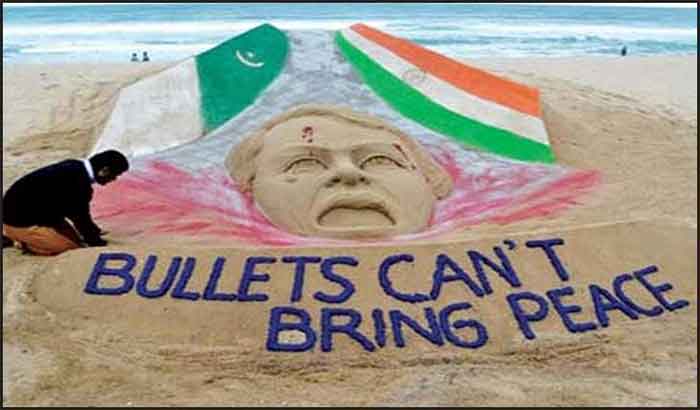
Since 2014, the Modi-led Central governments have systematically sought and substantially succeeded in undermining Indian federalism by reorganising Centre-state relations so as to enhance the relative powers and capacities for control and intervention of the former over the latter at the economic, political and legal levels. It doesn’t stop here. India must be culturally homogenised as much as possible along Hindutva lines. This is why, the BJP-RSS combine seeks to promote, to the extent possible, a uniformity of what is taught in schools; hence the New Education Policy (NEP) and its content changes and recommendations.
Furthermore, for the Sangh Parivar, a Sanskritised Hindi must become the most important link language across the country. It is precisely this thinking that lies behind the new effort to push the three-language formula for students in schools whether public or private. That is why there is the insistence that wherever this formula is applied, two of the languages must be Indian. The reaction from the Tamil Nadu government against this is justified because the motivation of this Hindutva dominated government at the Centre is obvious despite its assurance that no specific Indian language is to be imposed. To understand why, a little bit of history.
After independence India’s linguistic diversity and the sensitivity, especially of the non-Hindi speaking populations of the southern and eastern states, meant that there was an early realisation that all central governments even as they desired an Indian language (preferably Hindi since it was the most widely spoken minority language) alongside English to serve as wider link languages, would have to navigate very carefully by not showing favouritism to Hindi. So the original three-language proposal, reiterated with different nuances at times thereafter, was supposed to encourage Hindi speaking states to take up another Indian language as the counterpart to those outside the Hindi belt considering the adoption of Hindi among other choices. The capacity of primary and secondary schools in India to teach three languages was anyway very poor, indeed mostly non-existent, and in effect this three-language policy was a non-starter, never seriously followed anywhere but having the merit of leaving matters basically as they were without arousing language-related political tensions.
With the growing dominance of the BJP in the Hindi heartland, mostly government and government-aided schools besides offering English, offer Sanskrit as the second Indian language option besides Hindi, though there are hardly any serious takers for this third option. But it provides a face-saver for the current government when it pushes for the three-language formula to be adopted elsewhere in the south and east. It is a disguised way (after all it is supposed to be voluntary) of pushing Hindi outside the Hindi belt while not in any way seeking to promote non-Hindi regional languages among students inside the Hindi heartland. Indeed, there have been from time-to-time proposals to make Sanskrit compulsory between grades 5 and 8 in certain states of the north, e.g., Himachal Pradesh. This pressure is growing.
A much more sensible and realisable policy would be to have a compulsory two-language policy. Everywhere there are schools that either have as their medium the regional language or have English as the medium of instruction. There is no getting away from the fact that English is the international language and no matter the justified pride in one’s own language, people everywhere as well as educational institutions recognise this and are promoting its learning. In China, English is increasingly being taught at the primary level. The popular belief that studying in the English medium facilitates better future education and job prospects in India means there is a proliferation of such English-medium schools even when they are of a poor overall standard.
This is where a compulsory two-language system with proper monitoring of basic standards can cultivate the flourishing of all Indian languages as well as English. A practical policy that moves in this direction and is easily doable is to have a two-language policy in all primary and secondary schools, public and private up to, and including, Class X. In those schools where the medium is the regional language, give them the choice of choosing any second language, be it English or any other Indian language. But in English medium schools, the other language to be taught must be from among the languages of that region/state. Those schools who can, and have the financial capacity to do so, may also teach a third language.
Hindi and English will remain on a Pan-Indian scale the main link languages but without detriment or discrimination towards the other Indian languages which will continue to flourish as a result of students at the primary and secondary level developing a genuine bi-lingual capacity and skill. A democratic language policy must also pay attention to languages spoken by large sections of the population, number which are not yet part of the Eighth Schedule. This is desirable because with the increasing pressure of market forces nationally and globally many languages (particularly indigenous ones), identities and knowledge systems are under siege as never before.
The imposition of Hindi as a national language in India has been a contentious issue since the country’s independence in 1947. This historical critique is a helpful pointer to the politicization of divisive language politics.
The Indian Constitution, adopted in 1950, declared Hindi as the official language of the Union of India (Article 343). However, it also provided for the continued use of English for official purposes alongside Hindi for 15 years, after which Hindi would become the sole official language. In the early 1960s, the Indian government, led by Prime Minister Jawaharlal Nehru, began to promote Hindi as the national language. This move was met with resistance from non-Hindi speaking states, particularly in the south. Lal Bahadur Shastri, who succeeded Nehru as Prime Minister in 1964, played a crucial role in the Hindi imposition controversy. Shastri’s government announced that English would be phased out in favor of Hindi as the sole official language from January 26, 1965. The announcement sparked widespread protests and agitations in non-Hindi speaking states, particularly in Tamil Nadu. The protests turned violent, resulting in the loss of lives and property.
Shastri’s government was criticized for mishandling the situation. The imposition of Hindi was seen as an attempt to impose a “northern” language on the rest of the country, ignoring the linguistic diversity of India. The anti-Hindi agitations led to a significant shift in the government’s language policy. The Official Languages Act of 1963 was amended in 1967 to provide for the continued use of English alongside Hindi for official purposes. The Hindi imposition controversy left a lasting impact on Indian politics and language policy. It highlighted the importance of linguistic diversity and the need for a more inclusive approach to language policy.
In retrospect, the imposition of Hindi can be seen as a flawed attempt to impose a single language on a linguistically diverse country. The controversy highlighted the need for a more nuanced approach to language policy, one that recognizes and respects the linguistic diversity of India. After all, there are other languages in the so-called Hindi heartland. Punjabi is spoken by 30 million people, Kashmiri by 7 million people, Dogri by 2 million people, Himachali by 2 million people, Nepali (spoken by people in Nepal but also in Uttarkhand, and Sikkim), Bhojpuri by some 40 million people, Rajasthani by 20 million people. So, the Centre is imposing a language that is not the3 sole language of the North and disregards the plurality of languages. Hindi is not the original language of all these regions. The controversy also underscored the importance of federalism and the need for the central government to respect the linguistic and cultural rights of the states.
Overall, the Hindi imposition controversy serves as a reminder of the importance of linguistic diversity and the need for a more inclusive approach to language policy in India. The Hindi language controversy has heated up again, and this time, Amit Shah is at the center of the storm. It appears that Shah, India’s Home Minister, made some comments about B.R. Ambedkar, the chief architect of the Indian Constitution, which were taken out of context by the Congress party. Shah claims that his comments were edited and presented in a misleading way to create controversy. He’s urging people to listen to his entire statement to understand his true intentions. However, the damage is done, and the debate has reignited, with many accusing Shah of stirring up trouble.
It’s worth noting that the Hindi language issue has been a sensitive topic in India for decades, with many non-Hindi speaking states resisting attempts to impose Hindi as the national language. This latest development has added fuel to the fire, and it remains to be seen how the situation will unfold. A sensible solution to the language issue in India would prioritize inclusivity, diversity, and equal opportunities.
Here are some key components of how this can happen:
- Recognize and promote India’s linguistic diversity, and enhance/promote multilingualism with no single language imposed as the sole national language.
- Ensure equal status and opportunities for all languages, including Hindi, English, and regional languages.
- Continue to use English as an official language, alongside Hindi, to facilitate communication and access to opportunities.
- Recognize and promote regional languages as official languages in their respective states as a matter of cultural identity.
- Promote education in the mother tongue or regional language, with options for learning other languages, including Hindi and English.
- Encourage proficiency in multiple languages, including Hindi, English, and regional languages, to enhance employability and opportunities.
- Provide options for citizens to interact with the government and access services in their preferred language, including Hindi, English, and regional languages.
Subscribe to Our Newsletter
Get the latest CounterCurrents updates delivered straight to your inbox.
In order to promote and preserve India’s linguistic and cultural diversity through programs and initiatives, in a spirit of dialogue and mutuality, the Centre should encourage exchange and collaboration between language and cultural groups to foster mutual understanding and respect.
This solution alone will prioritize inclusivity, plurality, diversity, and equal opportunities, ensuring that no single language is imposed, and all languages are respected. A pluralistic India needs language must be a source of unity not tension. It could be a tool to achieve discard polarization and launch a moment of plurality. It should be one of celebration of our multiple linguistic heritage.
Ranjan Solomon is a political commentator














































